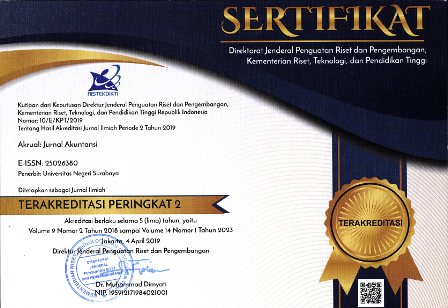Total Benchmarking Sebagai Alat Menilai Kewajaran Laporan Keuangan Dan Pemenuhan Kewajiban Perpajakan
DOI:
https://doi.org/10.26740/jaj.v6n1.p1-16Keywords:
Total Benchmarking, Tax Payer Compliance, Tax Obligation, Business Field ClassificationAbstract
Abstract
The objective of this research is to provide empirical evidence on the utilization of total benchmarking ratio as a mean to assess the fairness of financial statement and the fulfilment of tax obligation in financial intermediaries sector. Variables to be tested in this research are 14 ratio of benchmarking total consist of: Gross Profit Margin (GPM), Operating Profit Margin (OPM), Pretax Profit Margin (PPM), Corporate Tax to Turn Over Ratio (CTTOR), Net Profit Margin (NPM), Dividend Payout Ratio (DPR), Value-added Tax Ratio (pn), Salary/Sales Ration (g), Interest/Sales Ratio (b), Rent/Sales Ratio (s), Depreciation/Sales Ratio (py), Outside-business Revenue/Sales Ratio (pl), Outside-business Cost/ Sales (bl), Other-input/Sales Ratio (x). This research incorporates financial intermediaries sector because it has contributed to the 5 largest tax revenue in last 5 years. The research method used is descriptive qualitative method by calculating ratios then compare them to the benchmark set by the Directorate General of Taxes. The sample of this research is Business Field Classification (Klasifikasi Lapangan Usaha) in the financial intermediary sector: foreign exchange banks, insurance and consumer financing companies. The type of data used is secondary data, that is audited financial statements gathered form ICMD. The research results show that the largest ratio difference for foreign exchange banks and insurance companies is at interest expense; however, the largest ratio difference for consumer financing is at outside-business Costs.
References
Dattakumar, R., & Jagadeesh, R. (2003). A review of literature on benchmarking. Benchmarking: An International Journal, 10(3), 176-209. Literature on Benchmarking. Benchmarking: An International Journal 10 (3) : 176209. DOI: https://doi.org/10.1108/14635770310477744
Denkena, B., Apitz, R., & Liedtke, C. (2006). Knowledge-based benchmarking of production performance. Benchmarking: An International Journal, 13(1/2), 190-199.DOI: https://doi.org/10.1108/14635770610644673
Dragolea, L., & Cotîrlea, D. (2009). Benchmarking-a valid strategy for the long term?. Annales Universitatis Apulensis: Series Oeconomica, 11(2), 813.
Elmuti, D., & Kathawala, Y. (1997). An overview of benchmarking process: a tool for continuous improvement and competitive advantage. Benchmarking for Quality Management & Technology, 4(4), 229-243. DOI: https://doi.org/10.1108/14635779710195087
Grünberg, T. (2003). A review of improvement methods in manufacturing operations. Work study, 52(2), 89-93. DOI: https://doi.org/10.1108/00438020310462890
Maarif MS., & Hendri T. (2003). Manajemen Operasi. Jakarta: PT. Grasindo.
Martin, F. (2008). A performance technologist's approach to process performance improvement. Performance Improvement, 47(2), 30-40.
Moriarty, J. P., & Smallman, C. (2009). En route to a theory of benchmarking. Benchmarking: An International Journal, 16(4), 484-503. DOI: https://doi.org/10.1108/14635770910972423
Darmayasa, N., & Hardika, N. S. (2011). Perencanaan Pajak Dari Aspek Rasio Total Benchmarking, Kebijakan Akuntansi, dan Administrasi Sebagai Strategi Penghematan Pajak. Jurnal Bisnis dan Kewirausahaan, 7(3), 162-169.
PER 70/PJ/2007.Tentang Tata Cara Pelaksanaan Konseling Terhadap Wajib Pajak Sebagai Tindak Lanjut Surat Himbauan.
St-Pierre, J., & Delisle, S. (2006). An expert diagnosis system for the benchmarking of SMEs' performance. Benchmarking: An International Journal, 13(1/2), 106-119. DOI: https://doi.org/10.1108/14635770610644619
SE-96/PJ/2009 Tentang Rasio Total Benchmarking dan Petunjuk Pemanfaatannya.
SE-11/PJ/2010 Tentang Penetapan Rasio Total Benchmarking Tahap II.
SE-68/PJ/2010 Tentang Penetapan Rasio Total Benchmarking Tahap III.
SE-105/PJ/2010 Tentang Penetapan Rasio Total Benchmarking Tahap IV.
SE-139/PJ/2010 Tentang Penetapan Rasio Total Benchmarking Tahap V.
Steven, et, al. (2003). Key Management Models: The Management Tools and Practices that will Improve Your Business. London: Prentice Hall.
Damayanti, T. W., & Adiritonga, E. S. (2011). Ratio Total Benchmarking Sesuaikah Dengan Kondisi Wajib Pajak?(Studi Pada Empat Perusahaah Rokok Yang Terdaftar Di Bei). In Prosiding Seminar Nasional & Internasional (Vol. 1, No. 1)..
Undang-undang Nomor 28 Tahun 2007 tentang Ketentuan Umum dan Tata CaraPerpajakan
Undang-undang Nomor 36 Tahun 2008 tentang Pajak Penghasilan
Undang-undang Nomor 42 Tahun 2009 tentang Pajak Pertambahan Nilai Barang dan Jasa dan Pajak Penjualan Atas Barang Mewah
Waluyo & Wirawan, B. Ilyas, (2002). Perpajakan Indonesia.Jakarta: Salemba Empat.
Watson, GH. (1996). Strategic Benchmarking: How to Rate Your Companys Performance against the Worlds Best. Terjemahan. Jakarta: PT. Gramedia Pustaka Utama.
Downloads
Published
How to Cite
Issue
Section
License
Authors who publish with this journal agree to the following terms:
- Authors retain copyright and grant the journal right of first publication with the work simultaneously licensed under a Creative Commons Attribution-NonCommercial 4.0 International License that allows others to share the work with an acknowledgement of the work's authorship and initial publication in this journal.
- Authors are able to enter into separate, additional contractual arrangements for the non-exclusive distribution of the journal's published version of the work (e.g., post it to an institutional repository or publish it in a book), with an acknowledgement of its initial publication in this journal.
 Abstract views: 1322
,
Abstract views: 1322
, PDF Downloads: 1077
PDF Downloads: 1077




















